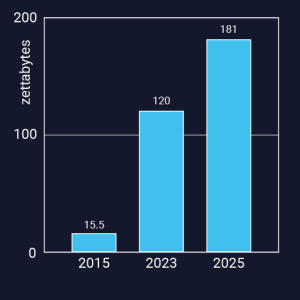 Stephen Birch
| 28 August 2024 |
Stephen Birch
| 28 August 2024 |
How can containerisation improve sustainability?

We’ve been aware of the green agenda for a long time now, and many businesses are having to find new ways to meet regulated or self-imposed environmental targets which form part of their business strategy. Containerisation could be a step in the right direction.
How many businesses consider their IT infrastructure when searching for areas where improvements can be made? More often than not transport, waste management and energy usage are top of the sustainability hit list.
 While computing power and accessible data storage are essential in today’s business world for achieving efficiencies across a host of functions, they are actually big contributors to the environmental impact that a company has. According to Edge Delta (quoting data from Statista), in 2023, 328.77 million terabytes of data were created daily. That’s an annual total of 120 zettabytes. It is forecast that by 2025, the volume of data created for the year will reach 181 zettabytes. Compare this to 2015 when the total was 15.5 zettabytes.
While computing power and accessible data storage are essential in today’s business world for achieving efficiencies across a host of functions, they are actually big contributors to the environmental impact that a company has. According to Edge Delta (quoting data from Statista), in 2023, 328.77 million terabytes of data were created daily. That’s an annual total of 120 zettabytes. It is forecast that by 2025, the volume of data created for the year will reach 181 zettabytes. Compare this to 2015 when the total was 15.5 zettabytes.
In ten years, that’s a more than a 1,000% increase!
8 Billion Trees estimate that 5.12kWh of energy is used per GB of transferred data, with a carbon footprint of 3kg per GB. 181 zettabytes of data, or 1.99×1014 GB, would use 8,140,000,000,000,000kWH (8,140,000,000 million GWh) of energy, equating to nearly 600 megatonnes of CO2 – the same mass as nearly 120 million elephants!
estimate that 5.12kWh of energy is used per GB of transferred data, with a carbon footprint of 3kg per GB. 181 zettabytes of data, or 1.99×1014 GB, would use 8,140,000,000,000,000kWH (8,140,000,000 million GWh) of energy, equating to nearly 600 megatonnes of CO2 – the same mass as nearly 120 million elephants!
This is the same energy that could be produced by Drax power station (the UK’s largest power station) in more that 42,000 years and has the same carbon footprint as driving an average petrol car around the world 55,122,365,848 times!
That is staggering!
It is generally accepted that data and storage requirements will continue to grow, so perhaps the question we should be asking ourselves is whether there is a more sensible approach we can take to storage solutions.
If we use more data, we need more storage, right? Solution: buy or rent more storage capacity at your data centre.
However, do we actually know what the data usage profile actually looks like? Or are we basing our requirements on peak usage? For example, in the banking world, there might be significant spikes in activity first thing in the morning when people check their balances, or at times in the month when organisations run their payroll. And for app developers, firing up test environments can be resource intensive.
But what about between these spikes? How much of the storage and processing capacity is being used? Is there scope for data usage to be dialled up and down as required?
This is where containerisation and containerised solutions come in.
By adopting a containerised system, perhaps based on Kubernetes (also known as k8s), you keep your data and apps in discreet units, or containers, which dynamically connect to each other, but only use the ones you need at the time of processing.
Kubernetes uses cluster architecture, with master nodes and worker nodes running the containerised applications, but the real power of Kubernetes comes from the orchestration. Here, Kubernetes automates different aspects of container management:
- It can deploy containers within the cluster based on a specification defined by the user.
- It will automatically scale applications up or down based on the usage metrics
- It will distribute network traffic to ensure stable deployment
- If a container fails, it will automatically restart, replace or reschedule the container.
In essence, with containerisation you are only paying for what you use. As demand increases, more containers become active, and as demand drops again, the unused containers deactivate.
So what are the environmental benefits of adopting a containerised solutions?
- Autoscaling means that resources are not left idling and only the necessary resources are used at any given time. This leads to reduced energy consumption compared to traditional virtual machine setups.
- Scaling testing environments up or down rather than leaving them running constantly, or even schedule them to be turned off when not required.
- Reducing the demand on data centres—among the largest and fastest-growing consumers of natural resources.
- Reducing the overall energy consumption of cloud infrastructure, which has a larger carbon footprint than the entire airline industry.
OK, so containerisation and Kubernetes isn’t going to solve the climate crisis, but it is certainly a step towards more sustainable development practices.
When you’re ready to make to move to containerised computing, get in touch with DeeperThanBlue, a Kubernetes Certified Service Provider.
Related Content
Kubernetes Certified Service Provider – Achieving Kubernetes Mastery
DeeperThanBlue, a distinguished member of the Cloud Native Computing Foundation (CNCF), has attained the coveted status of Kubernetes Certified ServiceFind out more
Cloud cost optimisation: Going into 2024, it’s more important than ever
In 2023, we’ve seen more businesses than ever continue their journey to the cloud. And whilst there are undoubted businessFind out more

